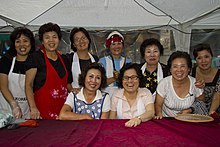 Korean Argentines at the Korean stand of the 2012 Gastronomic Patio held in Buenos Aires | |
| Total population | |
| 9,579 (by birth, 2023)[1] 23,089 (total of Korean citizens + Argentine citizens, 2023)[2] | |
| Regions with significant populations | |
| Buenos Aires, especially Flores and Balvanera (formerly known as Once)[3] | |
| Languages | |
| Spanish · Korean (minority) | |
| Religion | |
| Majority: Protestantism Minority: Catholicism and Buddhism[4] | |
| Related ethnic groups | |
| Koreans · Korean Americans · Korean Brazilians · Korean Uruguayans |
Koreans in Argentina (also known as Argentine Koreans or Korean Argentines) form the second-largest Korean diaspora community in South America and the 16th largest in the world, according to the statistics of South Korea's Ministry of Foreign Affairs and Trade. Their population declined by more than 50% between 1997 and 2003. Despite the small rebound in their numbers since then, they have been surpassed in size by the rapidly growing Chinese Argentine community (which since the 1990s has been increasing non-stop and is expected to become one of the biggest immigrant groups in Argentina, together with Paraguayan, Bolivian and Peruvian immigrants). In the 2010s decade, the Korean community in Argentina has fallen behind Korean communities in Australia, New Zealand, the United Kingdom, the United States, Brazil, Canada, Singapore, The United Arab Emirates, and Southeast Asia.[5][6]
Nevertheless, the relevance of the community and especially its weight among the Korean communities has been hailed on more than one occasion. For example, the Centro Cultural Coreano-Argentino (Korean-Argentine Cultural Center) was created with its headquarters precisely in Argentina.[7]
- ^ "Datos sociodemográficos por país de nacimiento". RENAPER - Dirección Nacional de Población. Retrieved 15 November 2023.
- ^ 재외동포현황2023. South Korea: Overseas Koreans Agency. 2023. pp. 34, 179. Archived from the original on 2024-09-07. Retrieved 2024-09-07.
- ^ Bialogorski 2005b, p. 3.
- ^ Bialogorski 2005a, p. 279.
- ^ 재외동포 본문(지역별 상세), Ministry of Foreign Affairs and Trade, 2011-07-15, p. 172, archived from the original on 2012-05-26, retrieved 2012-02-25
- ^ 재외동포현황 - 중남미 [Status of overseas compatriots - Central/South America], Overseas Korean Foundation, 2005, archived from the original on 2009-04-14, retrieved 2008-09-27
- ^ "Palabras del Director". argentina.korean-culture.org.